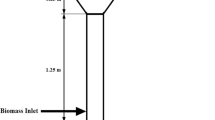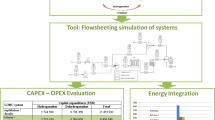Abstract
Optimum and economic operation of any process plant depends on the right selection of ΔT min. The estimated optimum ΔT min for the investigated fluid catalytic cracking unit was 20 °C instead of the prevailing 109 °C. The pinch point was also found to be 127–107 °C. There was a reduction in the process stream exergy loss from 9.11 MW in existing network to 3.83 MW in the proposed network. Energy cost saving of $2,189,041.60 was achieved by the proposed network. The economic implications of heat recovery improvement were modifications to the cold crude feed from tank inlet to the main fractionator, removal of split in the boiler feed water from deaerator stream and proper positioning of 17 barg steam generator. The capital cost for plant modification was $3,220,238.11 with payback period of 1.5 years.

Similar content being viewed by others
Abbreviations
- A :
-
Fixed cost of installation independent of area
- AF:
-
Annualization factor (/year)
- B :
-
Exchanger cost per unit area
- C u :
-
Utility cost
- F :
-
Correction factor accounting for non-countercurrent flow
- h :
-
Heat transfer coefficient
- MCp :
-
Heat capacity flow rate (kW/°C)
- Q j :
-
Enthalpy change of the jth stream
- Q u :
-
Total utility (kW)
- Q C :
-
Cooling utility demand (kW)
- Q H :
-
Heating utility demand (kW)
- ΔEx:
-
Exergy change (kW)
- ΔT min :
-
Minimum temperature difference
- ΔT lmtd :
-
Logarithmic mean temperature difference for the interval
- ΔQ :
-
Heat change (kW)
- σ T o :
-
Total exergy loss (kW)
- i :
-
Denotes to the i th enthalpy interval
- j :
-
Denotes to the jth stream
References
Kemp I.C.: Pinch Analysis and Process Integration. Elsevier, Amsterdam (2007)
Ataei A.: Modification of co-generation plant in a sugar cane factory for reduction of power deficit. Res. J. Environ. Sci. 3, 619–630 (2009)
Linnhoff, B.: Pinch analysis—a state of the art overview. Trans. IChemE Part A 71, 503–22 (1993)
El-Halwagi, M.M.: Process Integration. Elsevier, Amsterdam (2006)
El-Halwagi, M.M.; Harell, D.; Spriggs, H.D.: Targeting cogeneration and waste utilization through process integration. Appl. Energy 86, 880 (2009)
Worrell, E.; Galitsky, C.: Energy efficiency improvement and cost saving opportunities for petroleum refineries. In: International Energy Studies. Lawrence Berkeley National Library, USA (2005)
Linnhoff, B.; Polley, G.T.; Sahdev, V.: General process improvement through pinch technology. Chem. Eng. Prog. 84, 51–58 (1998)
Shenoy, U.V.: Heat Exchanger Network Synthesis; Process Optimization by Energy and Resource Analysis. Gulf Publishing Co, Houston (1995)
Bejan, A.; Tsatsaronis, G.; Moran, M.J.: Exergy Analysis of Thermal Systems–Thermal Design and Optimization. John Wiley and Sons, New York (1996)
Rivero R.: Application of the exergy concept in the petroleum refining and petrochemical industry. Energy Convers. Manag. 43, 1199–1220 (2002)
Dincer I.: The role of exergy in energy policy making. Energy Policy 30, 137–149 (2002)
Rosen, M.A.; Dincer, I.: On exergy and environmental impact. Int. J. Energy Res. 21, 643–654 (1997)
Wall, G.: Exergy— a useful concept. Ph.D. Thesis, Chalmers University of Technology, Sweden (1986)
Ahmadi, P.; Dincer, I.: Exergoenvironmental analysis and optimization of a cogeneration plant system using multimodal genetic algorithm (MGA). Energy 35, 5161–5172 (2010)
Rivero, R.; Rendon, C.; Gallegos, S.: Exergy and exergoeconomic analysis of the crude oil combined distillation unit. Energy 29, 1909–1927 (2004)
Zheng, L.; Pei, L.; Fen, H.; Minghua, W.; Efstratios, N.P.: Simulation and exergoeconomic analysis of a dual-gas sourced polygeneration process with integrated methanol/DME/DMC catalytic synthesis. Comput. Chem. Eng. 35, 1857–1862 (2011)
Allen, B.; Savard-Goguen, M.; Gosselin, L.: Optimizing heat exchanger networks with genetic algorithms for designing each heat exchanger including condensers. Appl. Them. Eng. 29, 3437–3444 (2009)
Nejad, S.H.A.; Shahraki, F.; Birjandi, M.R.S.; Kovac Kralj, A.; Fazlollahi, F.: Modification of heat exchanger network design by considering physical properties variation. Chem. Biochem. Eng. 26(2), 79–87 (2012)
Sami, M.; Lewis, F.: Chemistry of Petrochemical Processes, 2nd edn. Gulf Publishing Co, Houston (2000)
http://www.cetc-varennes.nrcan.gc.ca (2013). Accessed June 2013
Al-Riyami, A.; Jiri, K.; Simon, P.: Heat integration retrofit analysis of a heat exchanger network of a fluid catalytic cracking plant. Appl. Therm. Eng. 21, 1449–1487 (2001)
Yasar D.: Thermodynamic analysis. Arab. J. Sci. Eng. 38(2), 221–249 (2013)
Anozie, A.N.; Odejobi, O.J.: The search for optimum condenser cooling water flow rate in a thermal power plant. Appl. Therm. Eng. 31, 4083–4090 (2011)
Rosen Marc, A.: Using exergy to assess regional and national energy utilization, a comparative review. Arab. J. Sci. Eng. 38(2), 251–261 (2013)
Townsend, D.W.; Linnhoff, B.: Surface area targets for heat exchanger network. IChemE Annual Research Meeting, Bath
Linnhoff, B.; Ahmad, S.: Supertargeting or the optimization of heat exchanger networks prior to design. In: World Congress III, Chemical Engineering, Tokyo, vol. 4, pp. 822–825 (1986)
Sinnott, R.K.: Chemical Engineering Design, vol. 6, 4th edn. Elsevier Butter-Worth Heinemann, Oxford (2005)
http://www.me.mtu.edu/~jwsuther/erdm/pinchtech.pdf. Accessed Feb 2013
Al-Mutairi, E.M.; El-Halwagi, M.M.: Integration method for considering scheduling in design of heat exchanger networks. Appl. Therm. Eng. 29(17), 3482–3490 (2009)
Author information
Authors and Affiliations
Corresponding author
Rights and permissions
About this article
Cite this article
Al-Mutairi, E.M. Retrofit and Exergy Analysis of Fluid Catalytic Cracking Unit Using Heat Recovery Approach Temperature as Decision Criterion. Arab J Sci Eng 39, 3403–3414 (2014). https://doi.org/10.1007/s13369-014-0964-3
Received:
Accepted:
Published:
Issue Date:
DOI: https://doi.org/10.1007/s13369-014-0964-3




